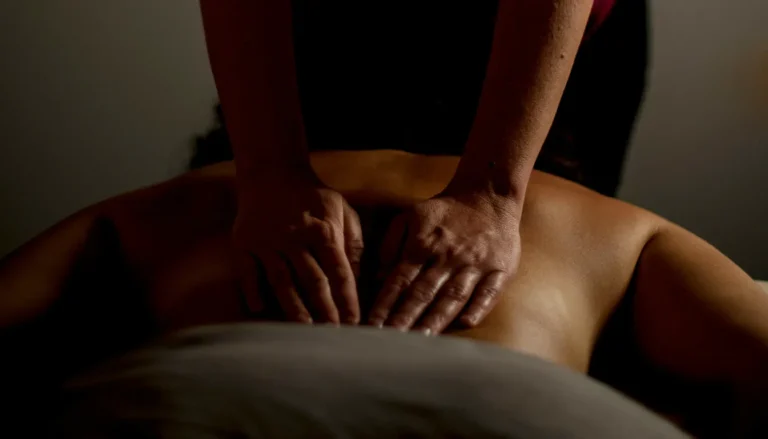This short guide explores practical, evidence-informed ways that gentle touch helps the body switch from a tense, alert state to a calmer one.
At a high level, skilled manipulation of tissue and muscle eases tension, warms soft tissue and boosts circulation. These shifts can lower heart rate and trigger feel-good hormones, which together make the body less reactive to everyday pressures.
Touch also interrupts pain signals before they reach the brain, easing the physical strain that often worsens anxiety and low mood. Whether stress arises from work, health concerns or sports, simple sessions — from a brisk 10-minute relaxer to a 20–30 minute therapy block — can help the mind and body recalibrate.
Massage helps by offering flexible, immediate benefits: relaxation, pain easing, reduced anxiety and greater contentment. For a clear summary of the measurable effects, see this concise report on massage and measurable stress reduction.

Key Takeaways
- Gentle tissue and muscle work promotes relaxation and lowers heart rate.
- Improved blood flow and warmth in soft tissue help relieve tension.
- Touch can interrupt pain signalling, easing related anxiety and low mood.
- Short or longer sessions both offer benefits for daily UK life and sport.
- Benefits include relaxation, pain relief, reduced anxiety and greater contentment.
Ways massage helps reduce stress: a quick overview of the body’s response
Gentle manual work on muscles and soft tissue sparks quick shifts in circulation and nervous activity. These changes warm local tissue, ease tension and support improved blood flow.
Key physical effects include:
- Lowered heart rate and slowed respiration, as the system moves toward parasympathetic nervous dominance.
- Reduced levels of stress-related hormones — single sessions often show immediate drops in salivary cortisol and heart rate.
- Eased muscle tightness and better local circulation thanks to gentle friction and pressure.
Research commonly uses 20–30 minute sessions, twice weekly over about five weeks, with pre‑ and post‑session measures. Results show acute wins are common; lasting changes need more study and may vary across a wide range of people.
Practical note: these physiological shifts explain why even brief massages can help you feel calmer before a meeting, after commuting or following intense training. Importantly, massages guide the body’s own systems toward a relaxed state rather than forcing changes.
Activating the parasympathetic nervous system for calm
Within minutes, gentle touch can shift the body into a quieter, more restorative mode. This change springs from the parasympathetic nervous system, the body’s “rest-and-digest” setting that balances the fight-or-flight response.
Vagus nerve stimulation and the relaxation response
The vagus nerve is a vital part of this system. It links the brain with the heart, lungs and digestion. Targeted work around the head, neck and shoulders can lightly encourage vagal activity and a calmer physiological response.
Heart rate variability (HRV): why higher variability signals calm
Higher HRV means a flexible heart rhythm and better ability to adapt. Low HRV is common when the body is tense or anxious.
Short, gentle sessions change the system fast
A study found just 10 minutes of treatment raised HRV and lowered perceived stress. Both moderate-pressure head-and-neck work aimed at vagal stimulation and softer contact around the neck and shoulders helped, though the moderate approach showed the largest effect.
- Notice steadier breathing and a slower heart rhythm.
- Feel less tension in the shoulders and jaw.
- Try a seated neck-and-shoulder routine or a brief head session between commitments.
| Measure | Before (avg) | After 10 mins | Practical note |
|---|---|---|---|
| HRV | Lower | Higher | Improved heart rhythm flexibility |
| Perceived stress | Higher | Lower | Participants reported feeling calmer |
| Respiration rate | Faster | Slower | Signs of parasympathetic engagement |
Lowering heart rate and easing blood pressure for immediate relief
A brief hands-on session often calms the nervous system within minutes, producing measurable drops in heart rhythm and breathing rate.
What typically happens: muscles relax, breathing deepens and heart rate falls, reflecting a quick shift toward parasympathetic control. Single sessions frequently show immediate heart rate reductions in clinical studies.
Mechanism behind the change
Parasympathetic activation slows respiration and settles the heart. As breathing becomes steadier, heart rhythm and blood flow stabilise together, which many people notice as a calmer, lighter sensation.
Evidence on blood pressure
Some trials report modest improvements in diastolic blood pressure after treatment, but sustained changes are not consistently found across research. Short-term gains are common; long-term effects vary by individual.
- Tip: focus on slow exhalations during a session to complement the body’s tendency to lower heart rate and ease blood pressure.
- Expect rebound: once back in a busy environment, measurements can climb again; regular sessions train the system to regain calm more readily.
- Contexts for quick relief: before exams, after commuting or when winding down for sleep.
- Comfort note: gentle, soothing contact can give benefits without deep pressure.
| Measure | Typical immediate change | Practical note | Long-term evidence |
|---|---|---|---|
| Heart rate | Decrease | Visible within minutes after treatment | Consistent single-session reduction; long-term gains less certain |
| Respiration rate | Slower | Often deepened breathing and steadier rhythm | Linked to parasympathetic tone |
| Diastolic blood pressure | Modest improvement (sometimes) | Helpful for immediate relief in some people | Mixed evidence for lasting change |
Note on individuality: medications, fitness and general health affect responses. Monitor your own reactions and adjust session length accordingly. Next, we’ll look at key hormones and what single sessions reveal versus longer-term patterns.
Balancing stress hormones: cortisol, catecholamines and realistic expectations
A single session commonly triggers a quick fall in salivary cortisol and a calmer heartbeat. Across 25 studies, short treatments often produced immediate drops in salivary cortisol. These changes appear reliably right after treatment, then tend to return toward baseline over days or weeks.
Single-session drops versus longer-term patterns
Cortisol is a key stress hormone. Many trials show a fall in salivary cortisol immediately post-session. However, structured programmes (typically 20–30 minutes, twice weekly for about five weeks) rarely produced sustained cortisol reductions across the full course.
Epinephrine and norepinephrine: mixed evidence
Evidence for urinary epinephrine and norepinephrine is inconsistent. Most studies show little or no lasting change in these catecholamines, suggesting the primary hormonal impact lies with salivary cortisol and autonomic shifts such as heart rate.
Setting realistic expectations
Repeatable acute gains are a dependable outcome: lower salivary cortisol and reduced heart rate after sessions are common.
“Expect predictable short-term hormonal changes; long-term shifts are less certain and vary by individual.”
- Typical protocol: 20–30 minutes, twice weekly for ~5 weeks yields repeated short-term effects.
- Practical tip: schedule treatments around high-pressure days to harness immediate calming.
- Remember: health, medication and baseline levels shape individual responses—track your patterns.
Big picture: even if average hormone levels normalise later, that post-session calm can improve sleep, coping and mental health on the day. Next: how easing muscle tension and pain also lowers physical drivers of anxiety.
Releasing muscle tension and easing pain to calm the mind
Increasing blood flow with light friction prompts sore spots to soften and pain signals to quiet. Gentle work on tight areas raises local temperature, which helps muscles let go.
Soft tissue and circulation
Targeted strokes boost blood circulation, bringing nutrients to strained places and clearing waste that can worsen pain. This simple shift often makes movement easier and reduces local tension.
Pain gating and mood
Pleasant touch competes with pain signals travelling to the brain. When those signals fall, perceived pain drops and the mind follows—anxiety eases and mood lifts.
“Less pain often means clearer thinking, better sleep and a greater sense of calm.”
- Focus areas: neck, shoulders and lower back respond well to tissue massage for desk-related tightness.
- Short practice: a few minutes on tight calves or forearms after sport gives quick relief.
- Tools: use a tennis ball or self-massage rollers to extend benefits between therapy sessions.
| Action | Immediate effect | Practical tip |
|---|---|---|
| Gentle friction | Warms tissue, improves circulation | Use slow, even strokes for 3–5 minutes |
| Pleasant touch | Blocks pain signals, lowers perceived pain | Combine with slow breathing for better results |
| Regular sessions | Less recurring tension, improved mood | Schedule short, frequent appointments or self-care |
Big picture: easing physical drivers of pain supports health and can cut perceived stress and symptoms of anxiety depression over time.
how do massage reduce stress in everyday life and sport?
Practical sessions can be tailored to fit daily life, from quick desk routines to focused sports recovery. Small, regular interventions help the body release tension and restore circulation without disrupting work or training.
Types of therapy at a glance
Soft tissue work eases general tightness and improves blood circulation for everyday relief. Deep tissue targets stubborn adhesions and longer-term stiffness. Sports treatment focuses on pre- and post-event needs to support performance and recovery.
When this helps most
At work, short neck and lower-back sessions cut screen-related tension. For health issues, targeted contact can ease pain and anxiety and support sleep—coordinate with your clinician first.
Session time and frequency
Many trials use 20–30 minute sessions twice weekly over about five weeks. Brief top-ups between appointments can maintain gains in circulation and mood.
Safety notes
Seek advice before treatment if you have circulatory problems, uncontrolled blood pressure, recent surgery or pregnancy. Track your range of responses and choose tissue massage options that suit your life and goals.
“Choose the style that fits your goal: comfort, recovery or deeper repair.”
For clinical guidance on benefits and practical tips, see this concise benefits for stress.
Mood, mental health and overall well-being: the broader benefits
When the body lets go, the mind often follows — small changes in tension can shift mood fast.
From tension relief to improved mood and contentment
Releasing tight muscles and easing pain creates room for calmer thoughts. This physical change gives the brain a clearer signal that the environment is safer, which helps emotions steadier and attention sharper.
Short sessions activate the parasympathetic nervous system and often raise HRV, with many participants reporting they felt less anxious and more content after ten minutes. These immediate shifts support better sleep and a grounded state that makes daily challenges easier to face.
Hormones change in the moment, too: single sessions commonly lower cortisol levels briefly, which can lift mood and improve coping for the day. Lasting hormonal shifts are mixed, but the acute benefits are reliable for many people.
“Even brief, regular contact can become a steady anchor during a busy week.”
- Use short shoulder or head work at home or at work to reset the state quickly.
- Try gentle, rhythmic styles if you prefer light pressure; personal preference matters.
- Think of this as a complement to therapy and other mental health care, not a replacement.
Conclusion
Even brief, focused sessions reliably move the body into a calmer state. Single treatments commonly lower heart rate and salivary cortisol, with some trials also reporting modest diastolic blood pressure gains.
Practically, ten minutes can raise HRV and settle nerves, so short routines fit busy days. Weekly 20–30 minute appointments or quick top-ups around tense moments are effective ways to gain relief.
While long-term hormone levels show mixed results, repeatable short-term benefits support mood, ease pain and bolster overall health and mental health resilience. Find what suits you, adjust pressure and length, and seek professional advice for specific concerns.
For guidance on treatment choices and options that may best suit your needs, see this short guide on what type of massage is best for. Small, regular steps help your body learn a calmer response and feel more at ease each week.
FAQ
What physiological systems does massage influence to promote calm?
Massage activates the parasympathetic nervous system, so the body shifts from a ‘fight or flight’ state toward rest and repair. Tactile stimulation, pressure on soft tissue and rhythmic movement help engage the vagus nerve, slow breathing and lower heart rate, while improving local blood circulation to tissues.
Can short sessions really change nervous system activity quickly?
Yes. Brief, gentle sessions often produce measurable shifts in autonomic tone within minutes. Heart rate variability can increase and heart rate typically falls, indicating a move to a more relaxed state. These are repeatable acute effects that many people notice after a single visit.
How does this therapy affect heart rate and blood pressure immediately?
During and shortly after treatment, heart rate usually decreases and respiration slows. Some studies show modest reductions in systolic and diastolic blood pressure after sessions, especially in people with elevated levels, although results vary by technique and individual.
What changes occur in stress hormones following a session?
Single sessions commonly reduce salivary cortisol and can lower catecholamine activity (epinephrine, norepinephrine) transiently. Long-term hormone patterns are more complex and depend on session frequency, overall lifestyle and baseline health.
How does hands-on therapy help with muscle tension and pain?
Manual techniques relax muscle tissue, break down adhesions and increase blood flow. Reduced nociceptive input and improved circulation help gate pain signals in the nervous system, which in turn eases anxiety and improves mood.
Which types of therapy are best for everyday stress and for sports recovery?
Gentle Swedish-style or relaxation-focused treatments suit everyday stress and anxiety. Deep tissue and sports-specific approaches target chronic tightness and post-exercise soreness. Choice depends on goals: relaxation, pain relief or performance support.
How often and how long should sessions be for noticeable benefit?
Research commonly uses sessions of 30–60 minutes. For acute relief, weekly or biweekly visits can help; for chronic issues, regular scheduling over months often yields better outcomes. Short maintenance sessions still provide meaningful autonomic and mood benefits.
Are there safety considerations or people who should seek medical advice first?
Yes. Those with deep vein thrombosis, uncontrolled hypertension, certain infections, recent surgery, advanced osteoporosis or pregnancy complications should consult a clinician before treatment. A qualified therapist will screen for contraindications.
Can regular therapy help with anxiety and depressive symptoms?
Many people report improved mood, reduced tension and better sleep after consistent sessions. While not a replacement for clinical mental health care, manual therapy can be a valuable adjunct to psychotherapy or medication when recommended by a healthcare professional.
What realistic outcomes should people expect over time?
Expect reliable short-term relief of tension, lower heart rate and improved wellbeing after sessions. Longer-term reductions in baseline cortisol or persistent blood pressure changes require consistent treatment combined with lifestyle measures like exercise, sleep and stress management.





